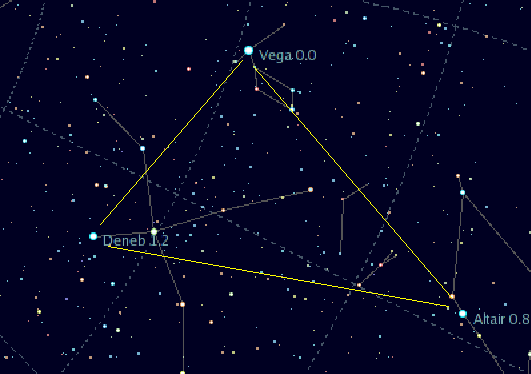 |
| Sheliak, Beta Lyrae image The Star Trek Museum of Science |
The second brightest star in Lyra constellation is called by a proper name, Sheliak. Arab astronomers coined this name الشلياق šiliyāq or Al Shilyāk which they use also as the name of the constellation. Prominent stars on northern and southern sky have been named in this manner with meaningful names in different languages and cultures.
But there are quite many stars also in the small constellation of Lyra and calling them by "personal names" is not practical. When Johann Bayer (1572 – 1625) published the star atlas Uranometria Omnium Asterismorum in 1603 he sorted the stars by their apparent brightness and called them with the constallation name and greek letters, the brightest one being alfa. According to the Bayer designation Sheliak is also known as beta Lyrae (β Lyr, β Lyrae).
The first Astronomer Royal John Flamsteed (1646–1719) published a catalog of 3000 stars in 1711. He abandoned the rather cumbersome Greek lettering scheme and used plain numbers instead. By the Flamsteed designation Sheliak is known as 10 Lyrae without indication of its brightness among the stars in Lyra.
The proper names and Bayer and Flamsteed numbers, as well as some other systems, are still widely used and astronomers are very familiar with them. However, with the growth of the power of telescopes these elegant old systems turn out to be impractical Henry Draper (1837-1882) used photographs to catalog that was expanded to include 225,300 stars. They are named simply by a number preceded by HD (or HDE for the extended map). This kind of abstarct naming is, of course, very hard for human brain to remember.
But there is no alternative. The Hubble Space Telescope Guide Star Catalog uses special codes and running numbers to identify uniquely the guiding lights among the billions of stars it can see up there in orbit around Earth.
Theological point
| "Psalms scroll" by Pete unseth - Own work. Licensed under CC0 via Commons |
מוֹנֶ֣ה מִ֭סְפָּר לַכּוֹכָבִ֑ים לְ֝כֻלָּ֗ם שֵׁמ֥וֹת יִקְרָֽא
He determines the number of the stars
and calls them each by name.
Psalm 147:4 NIV
Psalm 147 was written after the utter destruction of Jerusalem by the Babylonians in 587 BC. Somewhat surprisingly, it inserts a verse about the greatness of God of Israel who calls each star by name. We can deduct from this that there is a divine catalog of all stars in the Cosmos whose quantity is decided by God and who has his own nomenclature for each one of them.
More practically, the psalmist who has seen the totally ruined Temple still expresses faith in the might and power of God the Creator and Caretaker, whose house has been shattered to pieces by followers of Marduk and the holy treasures taken to Babylon.
Nobody could expect it but only a generation or so later the great King Cyrus of Persia conquered Babylon. He gave a degree in 530 BC that exiled Jews are allowed to return home and rebuild their Temple. Faith in God of Israel, who knows every star by a name, was not in vain or empty wishful thinking despite of the horrific tribulations. The Jews would never forget this lesson about their God.
It is likely that this beautiful psalm reflecting the power of God of Israel was written after return from exile in the fifth century BC as it is so full of praise and the horrors of war, destruction and exile seem to be behind.
Psalm 147:4 makes the entire Cosmos intensively personal.

